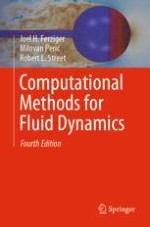2020 | OriginalPaper | Chapter
10. Turbulent Flows
Authors : Joel H. Ferziger, Milovan Perić, Robert L. Street
Published in: Computational Methods for Fluid Dynamics
Publisher: Springer International Publishing
Activate our intelligent search to find suitable subject content or patents.
Select sections of text to find matching patents with Artificial Intelligence. powered by
Select sections of text to find additional relevant content using AI-assisted search. powered by
